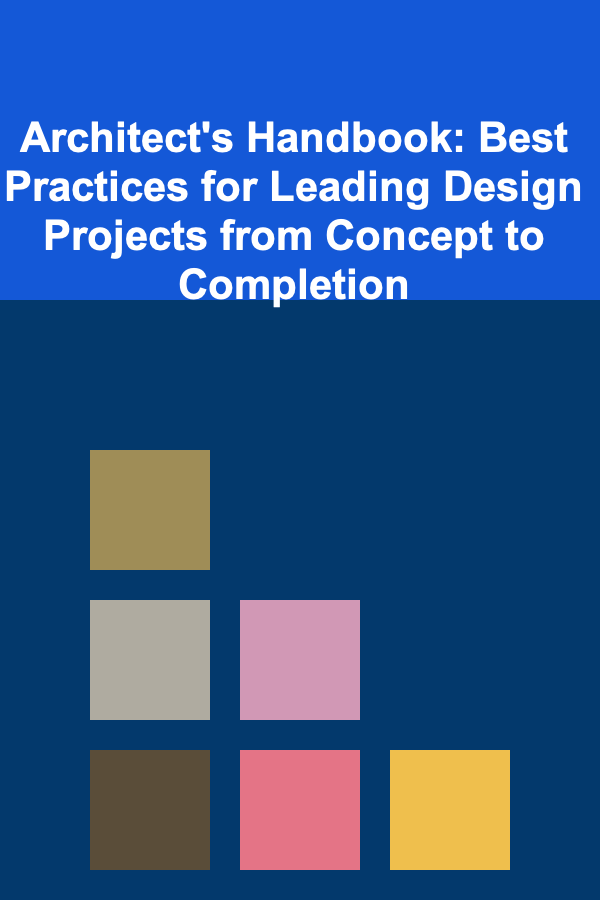
Architect's Handbook: Best Practices for Leading Design Projects from Concept to Completion
ebook include PDF & Audio bundle (Micro Guide)
$12.99$6.99
Limited Time Offer! Order within the next:

In the world of architecture, the path from a design concept to the completed structure is a complex and intricate journey. As an architect, you are not only responsible for the aesthetic and functional aspects of a building but also for the seamless orchestration of multiple stages in the design and construction process. Leading a design project involves managing clients, coordinating teams, maintaining timelines, and ensuring that every detail aligns with the project's goals. This guide explores best practices for architects to lead design projects effectively, from initial concept to final completion.
Establishing a Clear Vision
Understand Client Needs
Every successful project begins with understanding the client's vision, needs, and constraints. Before any design work begins, architects must have a deep understanding of the project's purpose. Are you designing a commercial office building, a cultural institution, or a residential space? Each type of project comes with its own set of unique requirements.
- Client Expectations: Establish clear communication with your client from the start. Understand not just what they want but why they want it. What are their goals? What challenges do they anticipate?
- Functional Requirements: Identify the functional needs of the space. This involves understanding the activities that will take place within the building and ensuring the design supports these activities effectively.
- Budget and Timeline: Setting realistic expectations around budget and project timeline is critical. Architects must navigate financial constraints and time pressures while maintaining design integrity.
Having a comprehensive understanding of the client's needs ensures that your design will meet expectations and solve the right problems.
Define the Project's Scope and Goals
Once you understand the client's needs, it's important to clearly define the scope of the project. This includes the overall size of the building, the specific spaces required, and any site-specific constraints. Setting goals helps to maintain focus and track progress throughout the project.
- Scope Definition: Determine the specific services you will provide, including design, documentation, and oversight during construction. If you are not responsible for construction management, specify that from the outset.
- Long-Term Vision: Discuss with your client the long-term functionality and sustainability of the building. Will it need to evolve over time? This foresight will guide design choices related to materials, systems, and flexibility.
By clarifying the project's goals early on, you can prevent scope creep (unplanned expansion of the project's scope) and ensure alignment with the client's expectations.
Comprehensive Site Analysis
Before embarking on a design, a thorough site analysis is essential. This process will help identify environmental, contextual, and technical factors that must be considered.
Environmental Considerations
- Climate and Weather: Understanding the climate of the site location is crucial for energy efficiency and occupant comfort. Analyze wind patterns, sunlight exposure, rainfall, and temperature variations to optimize natural heating, cooling, and lighting.
- Topography and Geology: The physical characteristics of the site, including elevation, soil type, and water drainage, influence the foundation and structural design.
- Surrounding Context: Pay attention to the surrounding environment, both natural and built. This includes neighboring buildings, street patterns, and views. Consider how the building will interact with its surroundings and integrate into the community.
Legal and Zoning Constraints
- Zoning Regulations: Every site has specific zoning restrictions, including allowable building heights, setbacks, and floor area ratios. Understanding local zoning laws and obtaining the necessary permits is crucial to avoid costly legal complications.
- Building Codes: Stay up-to-date on local building codes and standards. These codes govern safety, accessibility, and environmental considerations, and compliance is non-negotiable.
Site Visits
Perform site visits to gain a firsthand understanding of the site's conditions. This is your opportunity to assess the physical and environmental context, observe any existing structures, and engage with the community.
Collaborative Design Process
Interdisciplinary Collaboration
The design process is rarely a solo endeavor. Architects must collaborate with a variety of professionals, including structural engineers, mechanical engineers, electrical engineers, landscape architects, and contractors. Effective collaboration ensures that the design is feasible, safe, and functional.
- Early Collaboration: Bring engineers and contractors into the conversation early. The earlier you integrate their input, the fewer changes you will need to make later in the design process.
- Integrated Design: Using tools like Building Information Modeling (BIM) allows the entire team to collaborate on a shared digital platform. This facilitates real-time changes and ensures that everyone is working with the most up-to-date information.
Design Iteration
As the project evolves, there will be multiple design iterations. Architects must balance creativity with pragmatism, adjusting the design to meet the client's needs while adhering to technical constraints and budget limitations.
- Conceptual Design: Begin by sketching broad concepts and exploring multiple design directions. At this stage, focus on form, space, and functionality, keeping the client's needs at the forefront.
- Refinement and Detailing: After presenting the initial concepts to the client, refine the design based on feedback. Pay attention to details such as materials, textures, and lighting. These elements will define the final aesthetic.
- Sustainability: Ensure that sustainability principles are embedded throughout the design. Consider passive design strategies like natural ventilation and thermal mass, as well as energy-efficient materials and systems.
Managing Client Relationships
Clear Communication
Effective communication is the cornerstone of a successful client relationship. Throughout the design process, maintain regular contact with the client to ensure that their needs are being met and that they are satisfied with the progress.
- Progress Updates: Schedule regular meetings to present design updates and gather feedback. This helps to keep the client engaged and ensures that their concerns are addressed in a timely manner.
- Managing Expectations: Clients may have unrealistic expectations about budget, timeline, or scope. It's crucial to communicate early and clearly about any limitations and to offer solutions when challenges arise.
Handling Feedback and Revisions
Be prepared for feedback and revisions. Client preferences can evolve throughout the design process, and it's essential to approach feedback constructively.
- Balancing Client Requests: It's natural for clients to ask for changes, but as an architect, it's your job to guide them and ensure that changes do not compromise the integrity of the design. Offer alternative solutions when necessary.
- Documentation: Keep a detailed record of all communications and revisions. This not only helps prevent misunderstandings but also ensures that changes are tracked and documented in the project's history.
Documentation and Permit Approvals
Once the design has been finalized, architects must produce the necessary documentation to facilitate construction and comply with regulatory requirements.
Detailed Drawings and Specifications
- Construction Drawings: These include architectural plans, sections, elevations, and details that provide the builder with the information needed to construct the building. Drawings must be precise and thorough to avoid confusion on-site.
- Technical Specifications: These documents describe the materials, finishes, and systems used in the project. Specifications provide contractors with the technical data they need to source materials and perform work.
Permit Application
- Permit Submissions: Submit the required documents to the relevant local authorities to obtain the necessary building permits. Ensure that all codes and regulations are adhered to in the application process.
- Public Hearings: In some cases, projects may require public hearings or community engagement sessions. As an architect, you must be prepared to present your design to the public and address any concerns that arise.
Construction Administration and Quality Control
Construction Oversight
While the contractor takes the lead on-site, the architect's role in construction administration is vital to ensuring that the design is executed as intended. This involves regular site visits to monitor construction progress, resolve issues, and ensure quality control.
- Site Inspections: Conduct regular site inspections to check the quality of work and ensure that the construction aligns with the design intent.
- Addressing Issues: If unforeseen issues arise on-site---such as design inconsistencies, structural challenges, or material shortages---work closely with the contractor to find effective solutions without compromising the project's integrity.
Maintaining Communication with Stakeholders
Ensure that communication remains clear between all parties involved in the construction phase. This includes the contractor, subcontractors, engineers, and suppliers. Problems on-site can often be resolved through transparent communication and prompt action.
Project Completion and Handover
Final Inspections and Punch List
Once construction is complete, conduct a final inspection to ensure that the building meets the design specifications and any outstanding issues are resolved.
- Punch List: This is a list of final adjustments or repairs that need to be made before the project is officially complete. Ensure that the contractor addresses these items promptly.
- Client Handover: When the project is finished, provide the client with all necessary documentation, including maintenance manuals, warranties, and as-built drawings.
Post-Completion Follow-Up
It's important to follow up with the client after the project is complete to ensure their satisfaction. Address any post-construction concerns and evaluate the performance of the building.
- Client Feedback: Request feedback from your client regarding the design and construction process. This can help identify areas for improvement in future projects.
- Building Performance: Monitor the building's performance over time, especially if it incorporates sustainability features. This will help you assess whether the design's environmental goals were met.
Conclusion
Leading an architectural design project from concept to completion requires not just technical expertise but also leadership, communication, and organizational skills. By following these best practices, architects can ensure that their projects are successful, from understanding the client's vision to delivering a high-quality, functional building. Every phase of the project is an opportunity to demonstrate creativity, precision, and professionalism. With careful planning, collaboration, and dedication to excellence, architects can bring their designs to life and create spaces that inspire, support, and endure.

How to Design a Functional Home Office That Saves Space
Read More
How to Get Rid of Payday Loans
Read More
How to Maximize Your Investment Returns with a Rebalancing Strategy
Read More
How to Organize Baking Supplies for Quick Access
Read More
How to Reduce Turnover Rates in Your Rental Property
Read More
How to Start a Career in Translation or Interpreting: A Step-by-Step Guide
Read MoreOther Products

How to Design a Functional Home Office That Saves Space
Read More
How to Get Rid of Payday Loans
Read More
How to Maximize Your Investment Returns with a Rebalancing Strategy
Read More
How to Organize Baking Supplies for Quick Access
Read More
How to Reduce Turnover Rates in Your Rental Property
Read More